Improving Data Capture and Use: A Business Decision-Making Research
VerifiedAdded on 2023/06/12
|12
|1133
|369
Report
AI Summary
This report delves into the crucial role of data insights in shaping business decisions, particularly within the retail industry, using Tesco as a case study. It explores various types of data collected and utilized by organizations, differentiating between traditional market research and big data analytics. The report further examines how information is captured, stored, and managed, highlighting the impact of technological advancements on data utilization in decision-making processes. It emphasizes the strategic importance of data in daily operations, outlining a research approach to enhance data capture and usage. The conclusion underscores the significance of data-driven decision-making, facilitated by technological advancements, for reducing risks and staying updated with market trends, while also emphasizing the need for organizations to establish effective research outlines to optimize data utilization for superior decision-making.
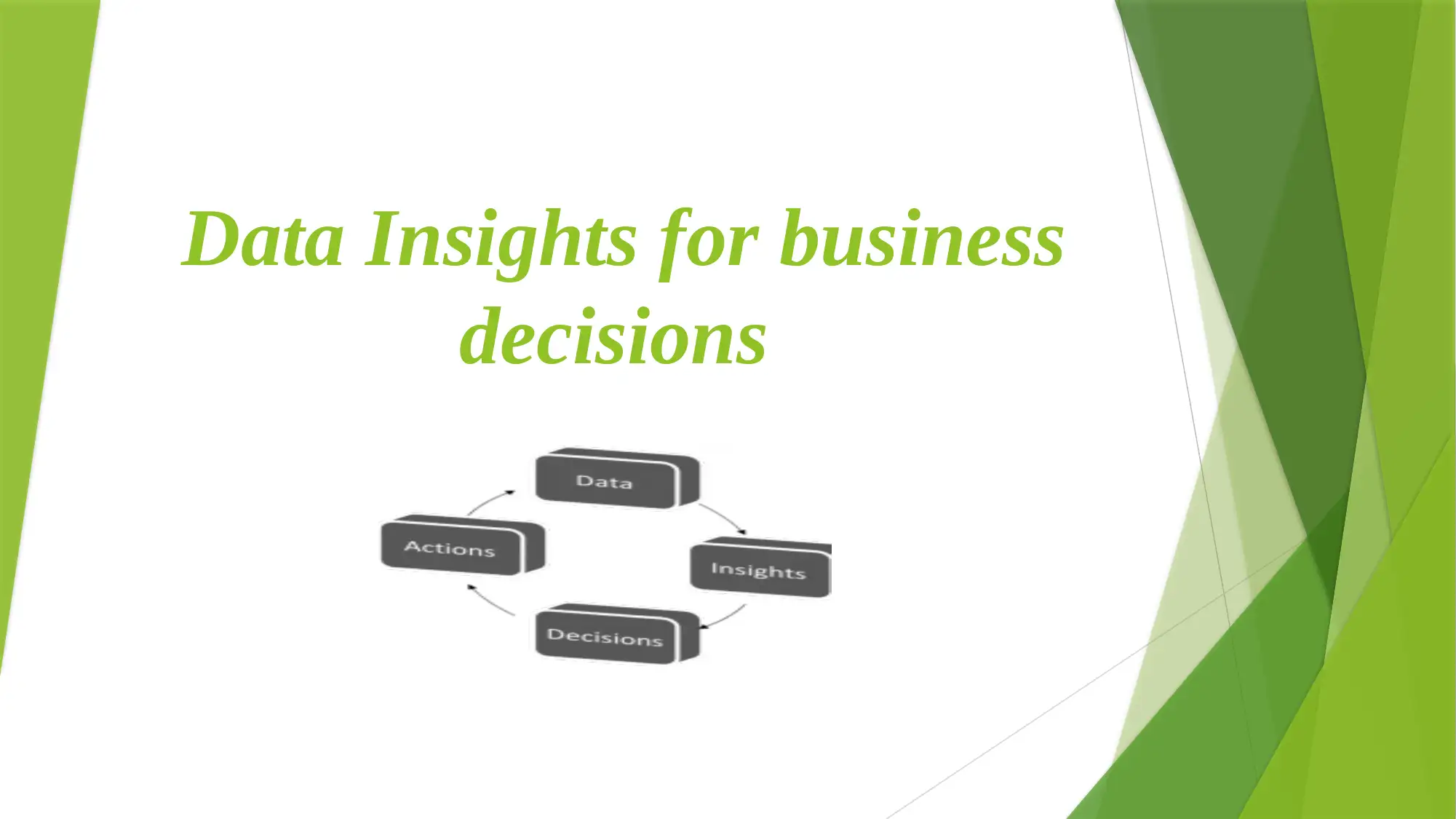
Data Insights for business
decisions
decisions
Paraphrase This Document
Need a fresh take? Get an instant paraphrase of this document with our AI Paraphraser
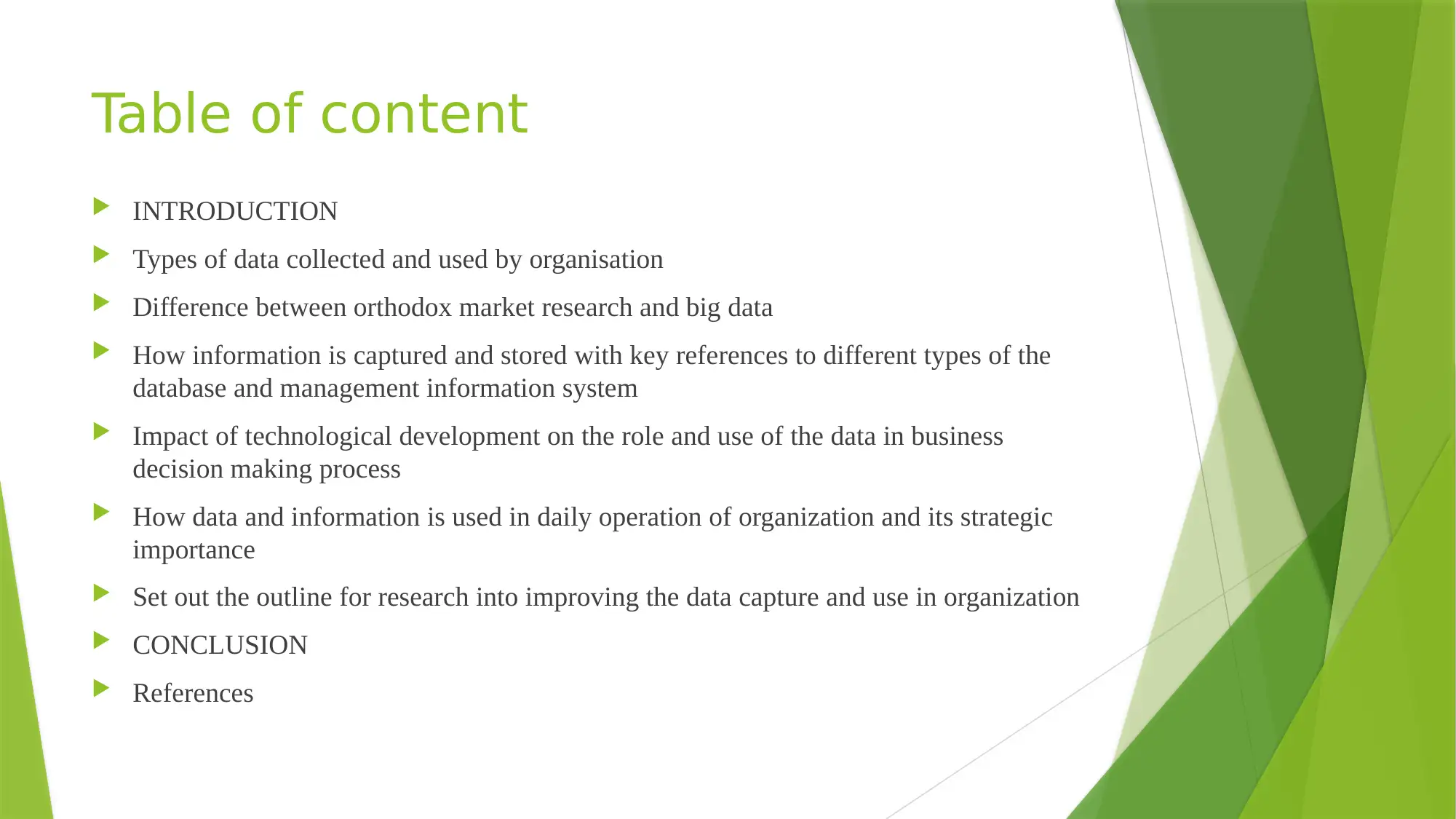
Table of content
INTRODUCTION
Types of data collected and used by organisation
Difference between orthodox market research and big data
How information is captured and stored with key references to different types of the
database and management information system
Impact of technological development on the role and use of the data in business
decision making process
How data and information is used in daily operation of organization and its strategic
importance
Set out the outline for research into improving the data capture and use in organization
CONCLUSION
References
INTRODUCTION
Types of data collected and used by organisation
Difference between orthodox market research and big data
How information is captured and stored with key references to different types of the
database and management information system
Impact of technological development on the role and use of the data in business
decision making process
How data and information is used in daily operation of organization and its strategic
importance
Set out the outline for research into improving the data capture and use in organization
CONCLUSION
References
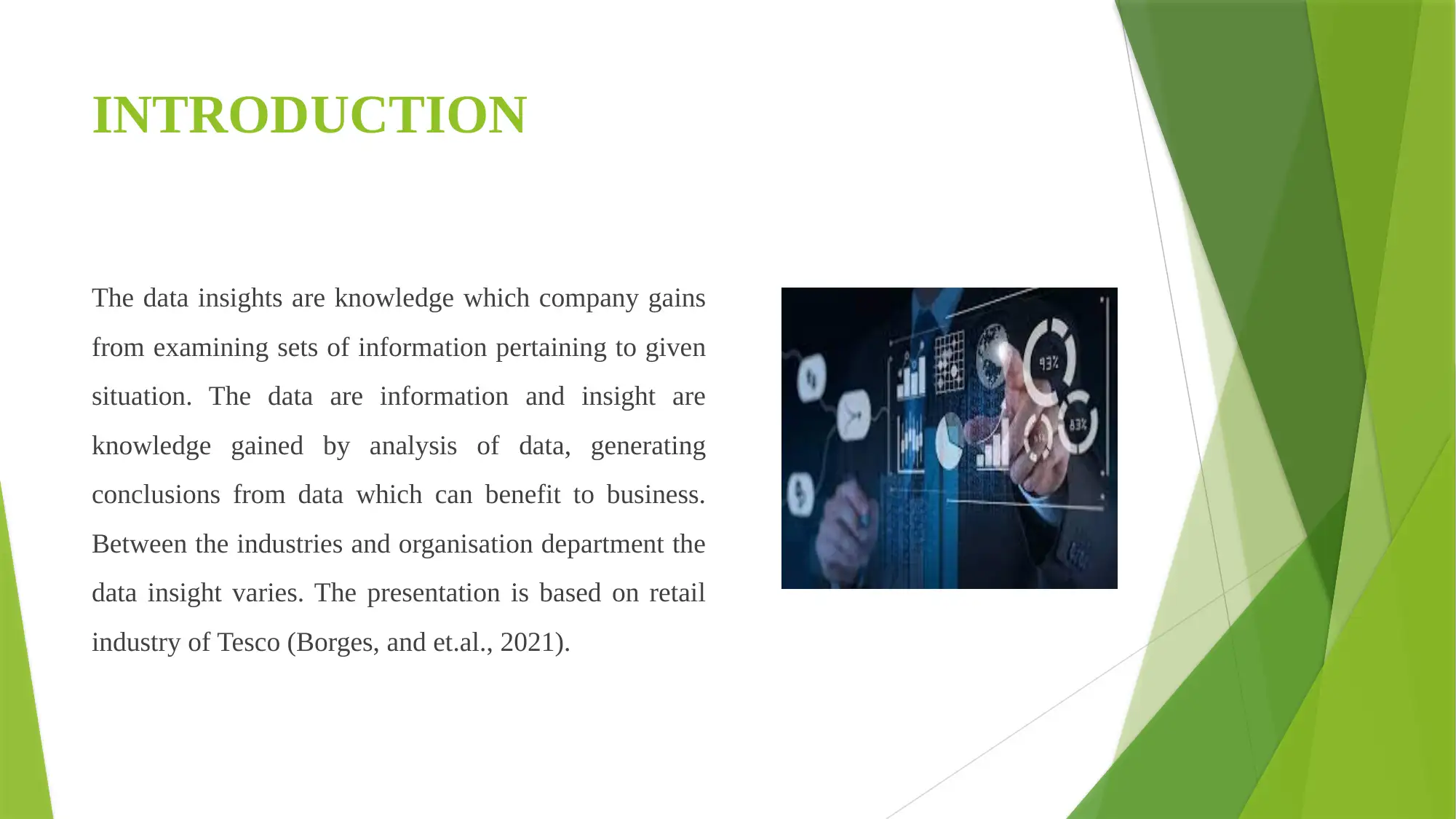
INTRODUCTION
The data insights are knowledge which company gains
from examining sets of information pertaining to given
situation. The data are information and insight are
knowledge gained by analysis of data, generating
conclusions from data which can benefit to business.
Between the industries and organisation department the
data insight varies. The presentation is based on retail
industry of Tesco (Borges, and et.al., 2021).
The data insights are knowledge which company gains
from examining sets of information pertaining to given
situation. The data are information and insight are
knowledge gained by analysis of data, generating
conclusions from data which can benefit to business.
Between the industries and organisation department the
data insight varies. The presentation is based on retail
industry of Tesco (Borges, and et.al., 2021).
⊘ This is a preview!⊘
Do you want full access?
Subscribe today to unlock all pages.

Trusted by 1+ million students worldwide
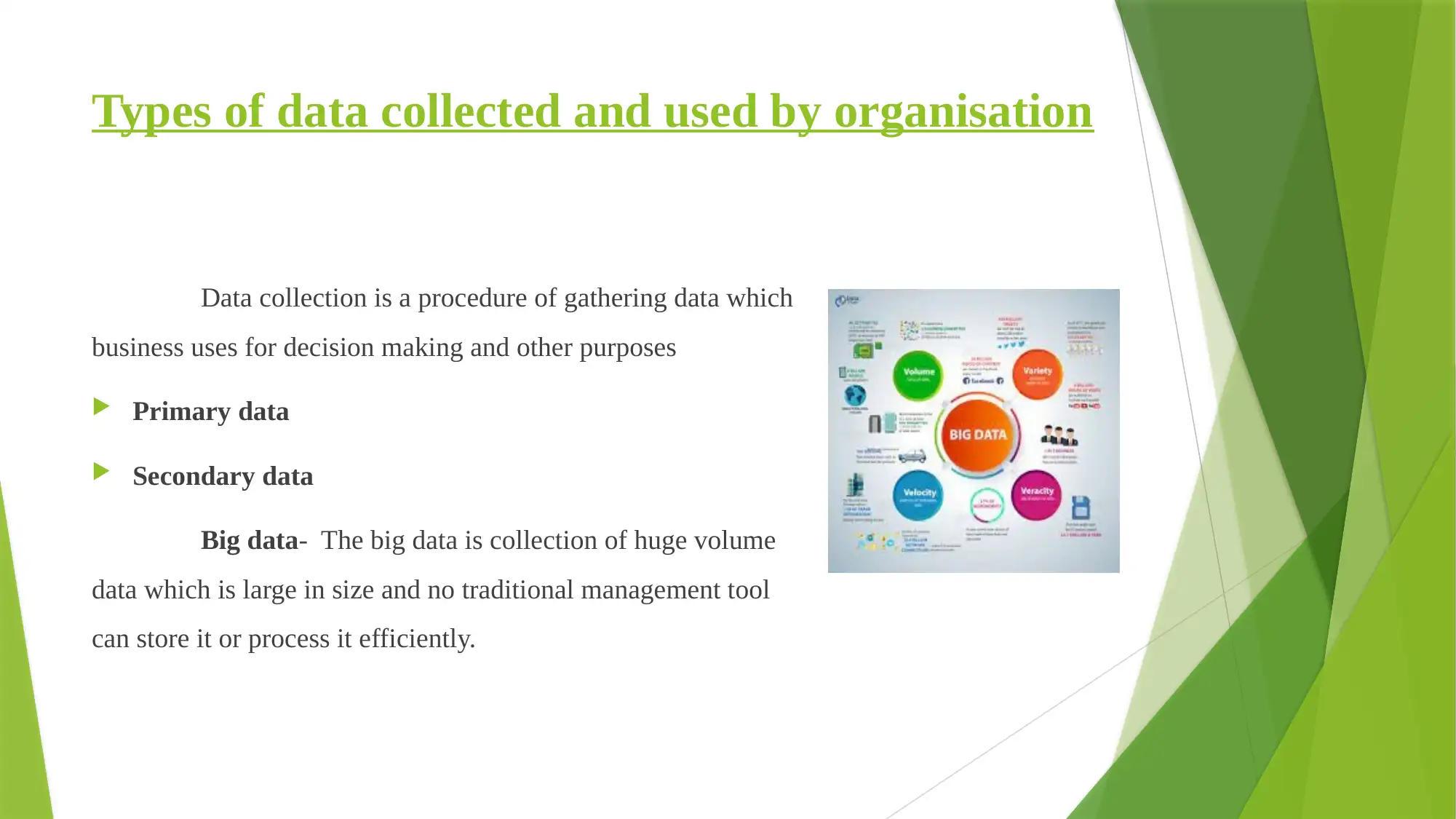
Types of data collected and used by organisation
Data collection is a procedure of gathering data which
business uses for decision making and other purposes
Primary data
Secondary data
Big data- The big data is collection of huge volume
data which is large in size and no traditional management tool
can store it or process it efficiently.
Data collection is a procedure of gathering data which
business uses for decision making and other purposes
Primary data
Secondary data
Big data- The big data is collection of huge volume
data which is large in size and no traditional management tool
can store it or process it efficiently.
Paraphrase This Document
Need a fresh take? Get an instant paraphrase of this document with our AI Paraphraser
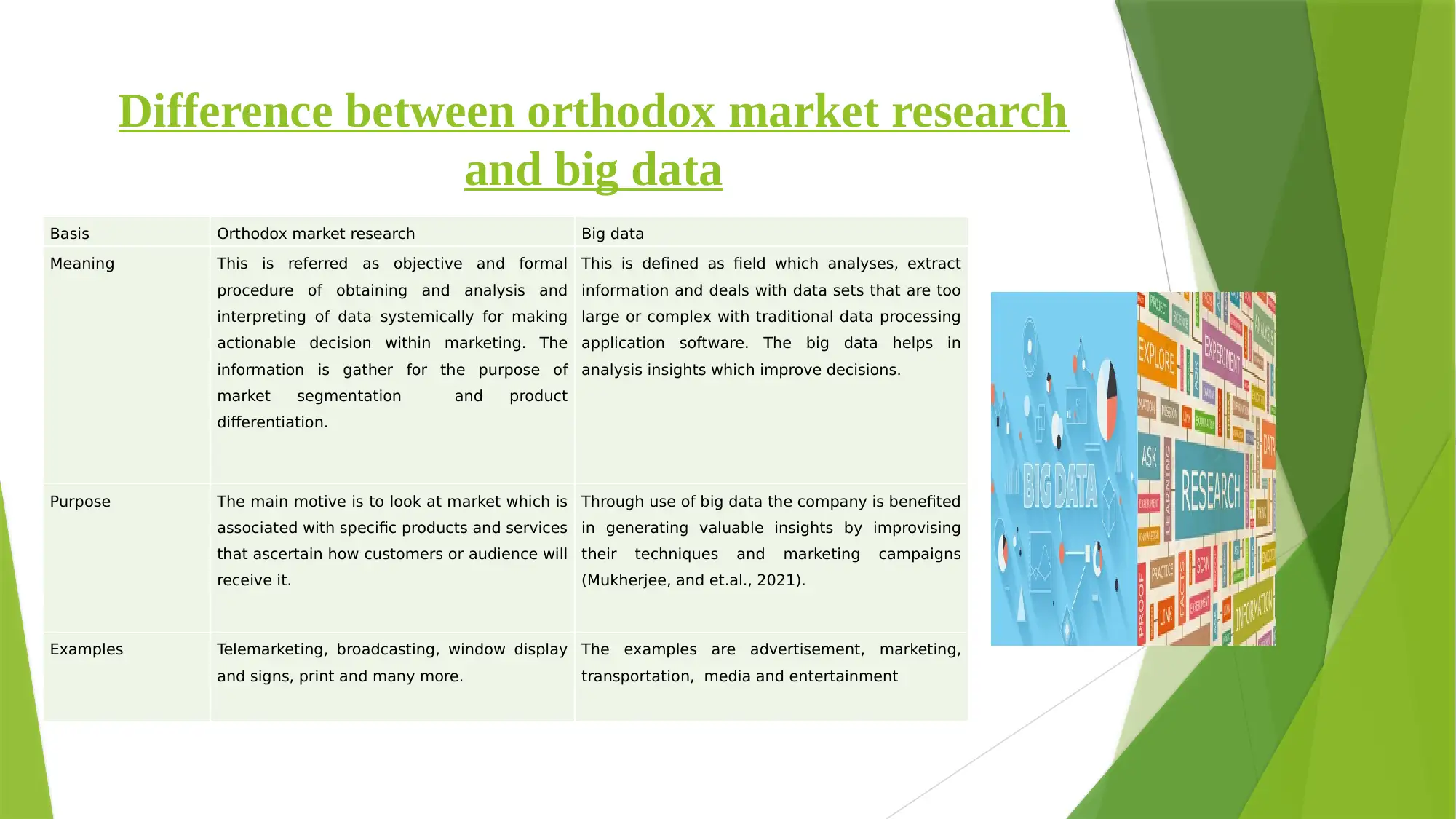
Difference between orthodox market research
and big data
Basis Orthodox market research Big data
Meaning This is referred as objective and formal
procedure of obtaining and analysis and
interpreting of data systemically for making
actionable decision within marketing. The
information is gather for the purpose of
market segmentation and product
differentiation.
This is defined as field which analyses, extract
information and deals with data sets that are too
large or complex with traditional data processing
application software. The big data helps in
analysis insights which improve decisions.
Purpose The main motive is to look at market which is
associated with specific products and services
that ascertain how customers or audience will
receive it.
Through use of big data the company is benefited
in generating valuable insights by improvising
their techniques and marketing campaigns
(Mukherjee, and et.al., 2021).
Examples Telemarketing, broadcasting, window display
and signs, print and many more.
The examples are advertisement, marketing,
transportation, media and entertainment
and big data
Basis Orthodox market research Big data
Meaning This is referred as objective and formal
procedure of obtaining and analysis and
interpreting of data systemically for making
actionable decision within marketing. The
information is gather for the purpose of
market segmentation and product
differentiation.
This is defined as field which analyses, extract
information and deals with data sets that are too
large or complex with traditional data processing
application software. The big data helps in
analysis insights which improve decisions.
Purpose The main motive is to look at market which is
associated with specific products and services
that ascertain how customers or audience will
receive it.
Through use of big data the company is benefited
in generating valuable insights by improvising
their techniques and marketing campaigns
(Mukherjee, and et.al., 2021).
Examples Telemarketing, broadcasting, window display
and signs, print and many more.
The examples are advertisement, marketing,
transportation, media and entertainment
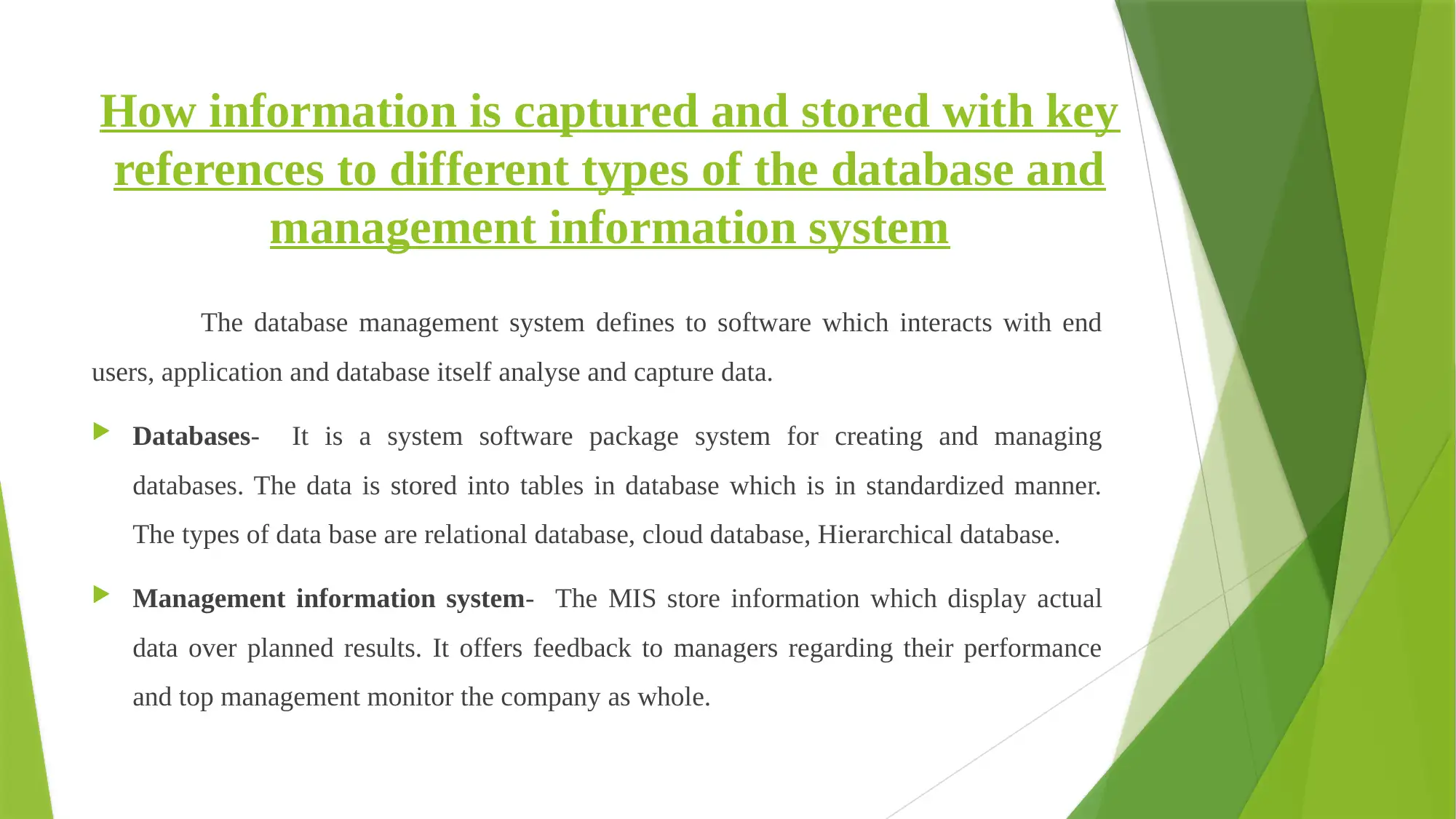
How information is captured and stored with key
references to different types of the database and
management information system
The database management system defines to software which interacts with end
users, application and database itself analyse and capture data.
Databases- It is a system software package system for creating and managing
databases. The data is stored into tables in database which is in standardized manner.
The types of data base are relational database, cloud database, Hierarchical database.
Management information system- The MIS store information which display actual
data over planned results. It offers feedback to managers regarding their performance
and top management monitor the company as whole.
references to different types of the database and
management information system
The database management system defines to software which interacts with end
users, application and database itself analyse and capture data.
Databases- It is a system software package system for creating and managing
databases. The data is stored into tables in database which is in standardized manner.
The types of data base are relational database, cloud database, Hierarchical database.
Management information system- The MIS store information which display actual
data over planned results. It offers feedback to managers regarding their performance
and top management monitor the company as whole.
⊘ This is a preview!⊘
Do you want full access?
Subscribe today to unlock all pages.

Trusted by 1+ million students worldwide
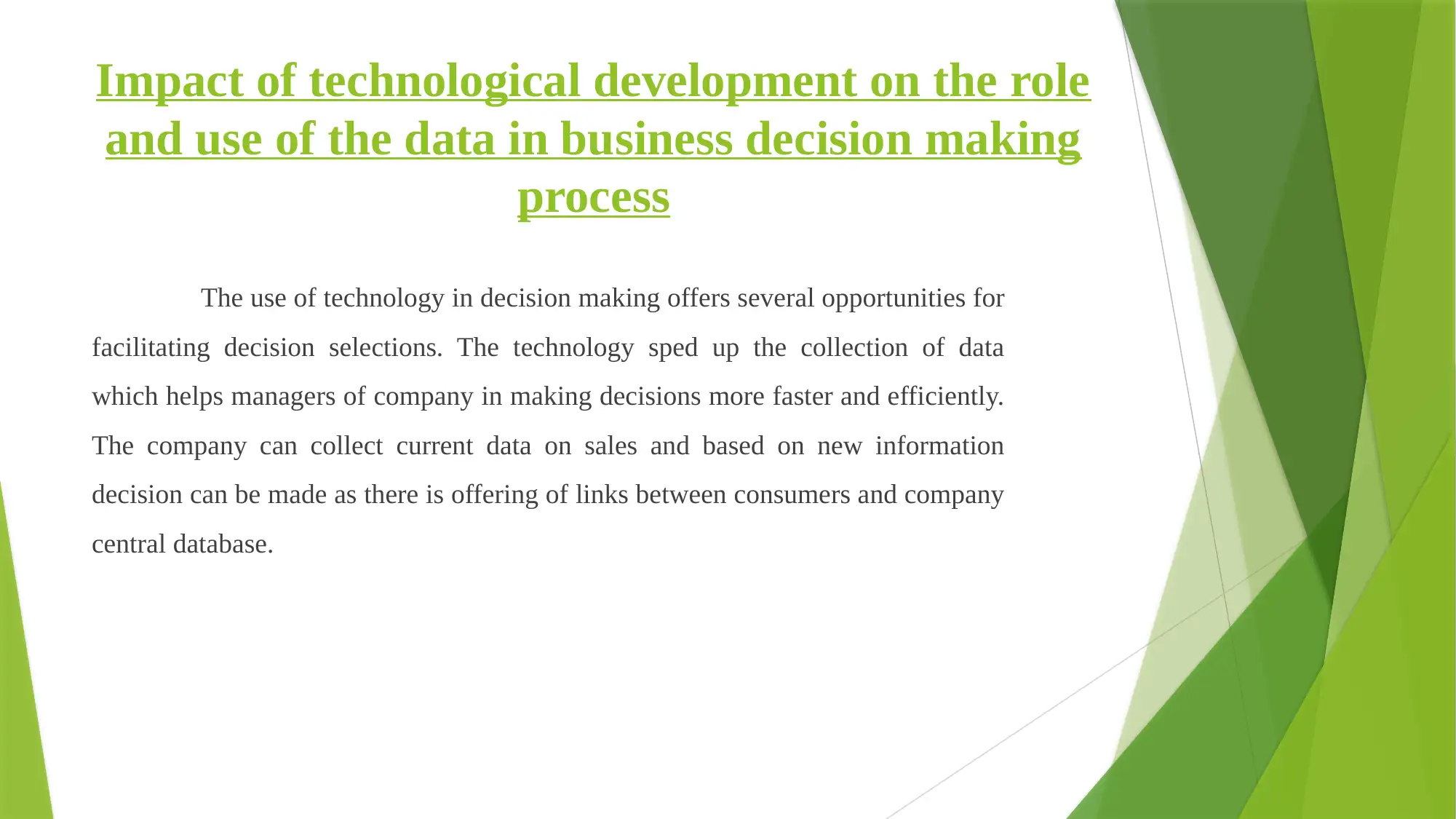
Impact of technological development on the role
and use of the data in business decision making
process
The use of technology in decision making offers several opportunities for
facilitating decision selections. The technology sped up the collection of data
which helps managers of company in making decisions more faster and efficiently.
The company can collect current data on sales and based on new information
decision can be made as there is offering of links between consumers and company
central database.
and use of the data in business decision making
process
The use of technology in decision making offers several opportunities for
facilitating decision selections. The technology sped up the collection of data
which helps managers of company in making decisions more faster and efficiently.
The company can collect current data on sales and based on new information
decision can be made as there is offering of links between consumers and company
central database.
Paraphrase This Document
Need a fresh take? Get an instant paraphrase of this document with our AI Paraphraser
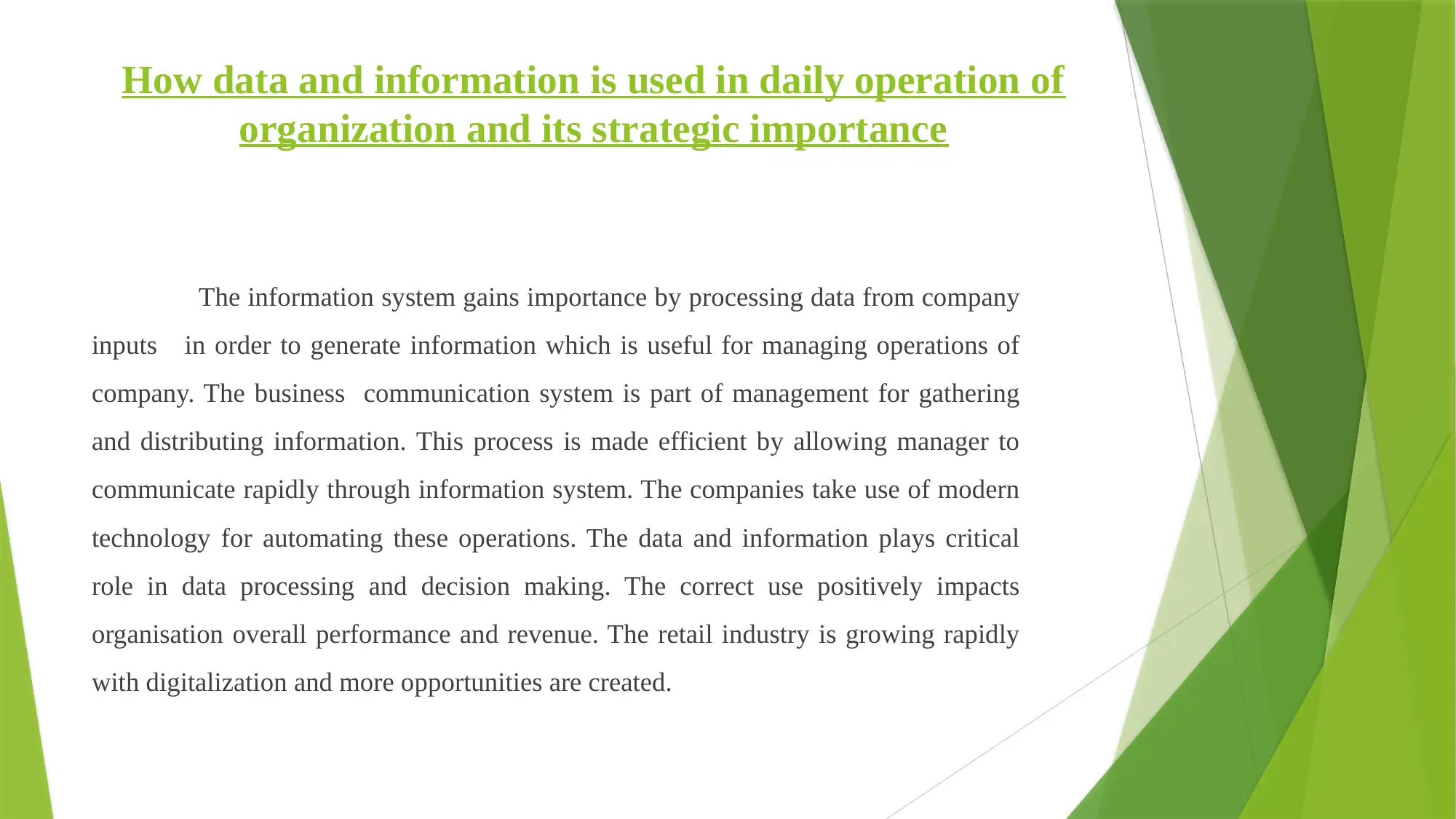
How data and information is used in daily operation of
organization and its strategic importance
The information system gains importance by processing data from company
inputs in order to generate information which is useful for managing operations of
company. The business communication system is part of management for gathering
and distributing information. This process is made efficient by allowing manager to
communicate rapidly through information system. The companies take use of modern
technology for automating these operations. The data and information plays critical
role in data processing and decision making. The correct use positively impacts
organisation overall performance and revenue. The retail industry is growing rapidly
with digitalization and more opportunities are created.
organization and its strategic importance
The information system gains importance by processing data from company
inputs in order to generate information which is useful for managing operations of
company. The business communication system is part of management for gathering
and distributing information. This process is made efficient by allowing manager to
communicate rapidly through information system. The companies take use of modern
technology for automating these operations. The data and information plays critical
role in data processing and decision making. The correct use positively impacts
organisation overall performance and revenue. The retail industry is growing rapidly
with digitalization and more opportunities are created.
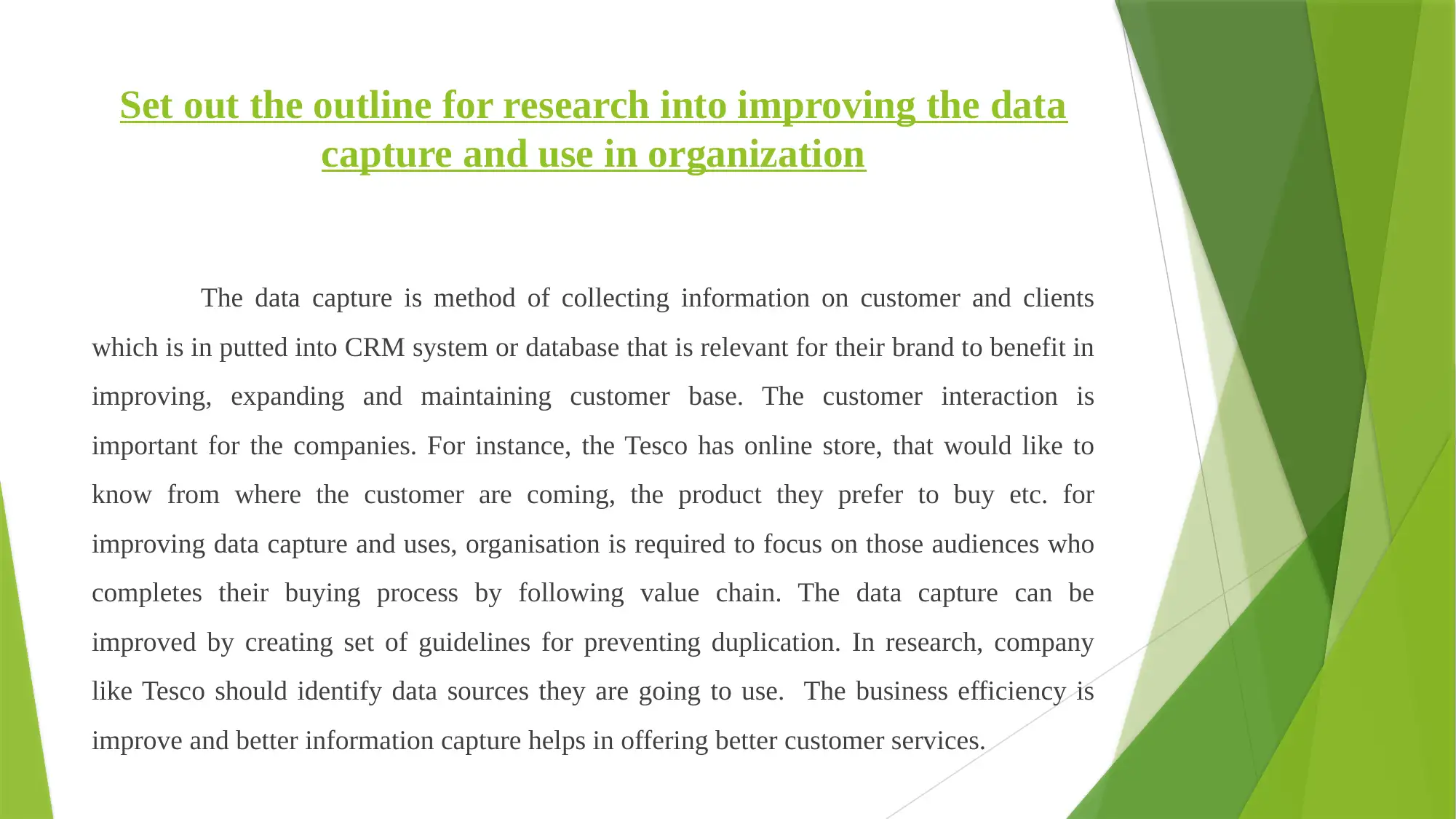
Set out the outline for research into improving the data
capture and use in organization
The data capture is method of collecting information on customer and clients
which is in putted into CRM system or database that is relevant for their brand to benefit in
improving, expanding and maintaining customer base. The customer interaction is
important for the companies. For instance, the Tesco has online store, that would like to
know from where the customer are coming, the product they prefer to buy etc. for
improving data capture and uses, organisation is required to focus on those audiences who
completes their buying process by following value chain. The data capture can be
improved by creating set of guidelines for preventing duplication. In research, company
like Tesco should identify data sources they are going to use. The business efficiency is
improve and better information capture helps in offering better customer services.
capture and use in organization
The data capture is method of collecting information on customer and clients
which is in putted into CRM system or database that is relevant for their brand to benefit in
improving, expanding and maintaining customer base. The customer interaction is
important for the companies. For instance, the Tesco has online store, that would like to
know from where the customer are coming, the product they prefer to buy etc. for
improving data capture and uses, organisation is required to focus on those audiences who
completes their buying process by following value chain. The data capture can be
improved by creating set of guidelines for preventing duplication. In research, company
like Tesco should identify data sources they are going to use. The business efficiency is
improve and better information capture helps in offering better customer services.
⊘ This is a preview!⊘
Do you want full access?
Subscribe today to unlock all pages.

Trusted by 1+ million students worldwide
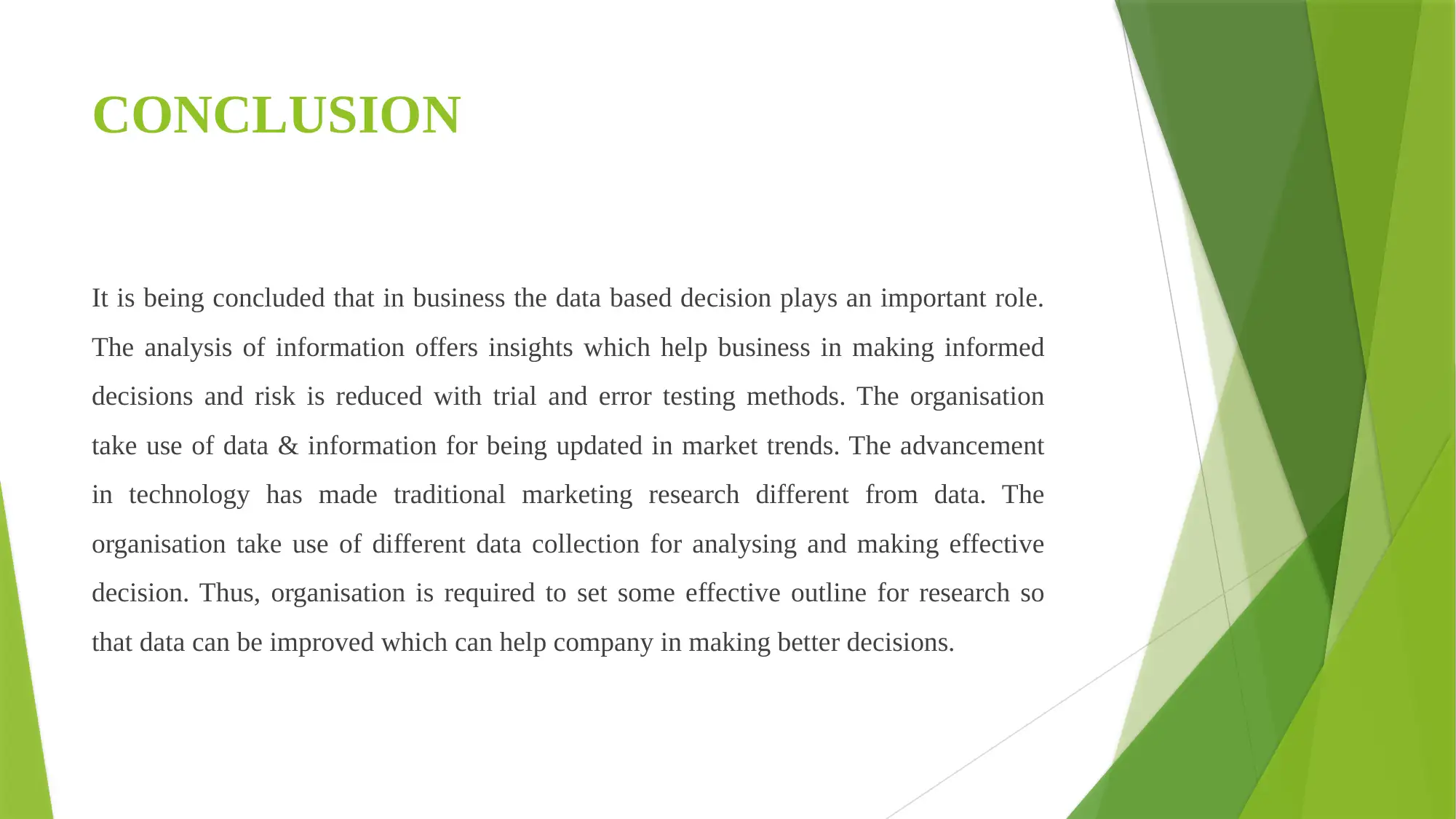
CONCLUSION
It is being concluded that in business the data based decision plays an important role.
The analysis of information offers insights which help business in making informed
decisions and risk is reduced with trial and error testing methods. The organisation
take use of data & information for being updated in market trends. The advancement
in technology has made traditional marketing research different from data. The
organisation take use of different data collection for analysing and making effective
decision. Thus, organisation is required to set some effective outline for research so
that data can be improved which can help company in making better decisions.
It is being concluded that in business the data based decision plays an important role.
The analysis of information offers insights which help business in making informed
decisions and risk is reduced with trial and error testing methods. The organisation
take use of data & information for being updated in market trends. The advancement
in technology has made traditional marketing research different from data. The
organisation take use of different data collection for analysing and making effective
decision. Thus, organisation is required to set some effective outline for research so
that data can be improved which can help company in making better decisions.
Paraphrase This Document
Need a fresh take? Get an instant paraphrase of this document with our AI Paraphraser
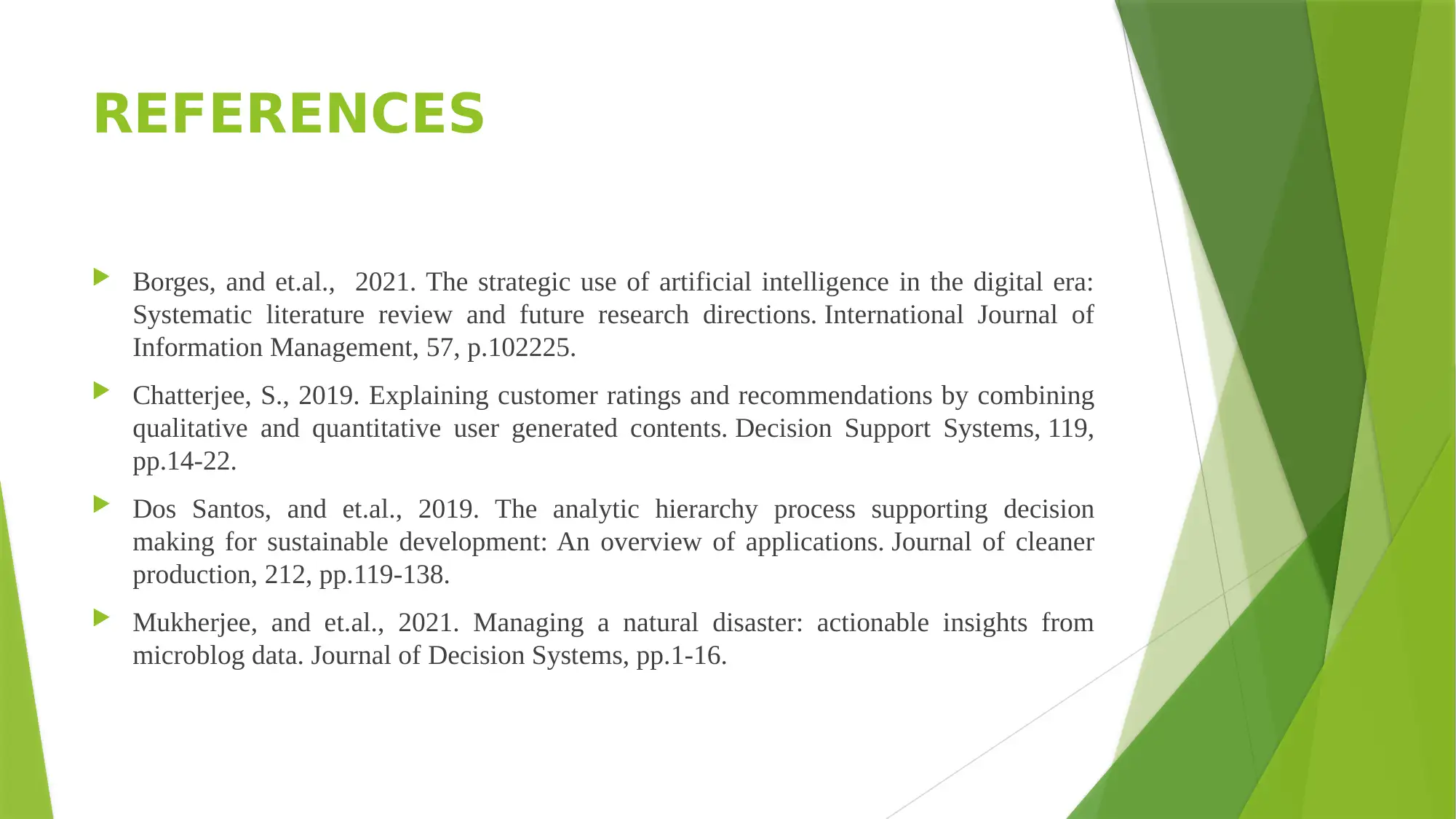
REFERENCES
Borges, and et.al., 2021. The strategic use of artificial intelligence in the digital era:
Systematic literature review and future research directions. International Journal of
Information Management, 57, p.102225.
Chatterjee, S., 2019. Explaining customer ratings and recommendations by combining
qualitative and quantitative user generated contents. Decision Support Systems, 119,
pp.14-22.
Dos Santos, and et.al., 2019. The analytic hierarchy process supporting decision
making for sustainable development: An overview of applications. Journal of cleaner
production, 212, pp.119-138.
Mukherjee, and et.al., 2021. Managing a natural disaster: actionable insights from
microblog data. Journal of Decision Systems, pp.1-16.
Borges, and et.al., 2021. The strategic use of artificial intelligence in the digital era:
Systematic literature review and future research directions. International Journal of
Information Management, 57, p.102225.
Chatterjee, S., 2019. Explaining customer ratings and recommendations by combining
qualitative and quantitative user generated contents. Decision Support Systems, 119,
pp.14-22.
Dos Santos, and et.al., 2019. The analytic hierarchy process supporting decision
making for sustainable development: An overview of applications. Journal of cleaner
production, 212, pp.119-138.
Mukherjee, and et.al., 2021. Managing a natural disaster: actionable insights from
microblog data. Journal of Decision Systems, pp.1-16.

Thank you
⊘ This is a preview!⊘
Do you want full access?
Subscribe today to unlock all pages.

Trusted by 1+ million students worldwide
1 out of 12
Related Documents
Your All-in-One AI-Powered Toolkit for Academic Success.
+13062052269
info@desklib.com
Available 24*7 on WhatsApp / Email
![[object Object]](/_next/static/media/star-bottom.7253800d.svg)
Unlock your academic potential
Copyright © 2020–2025 A2Z Services. All Rights Reserved. Developed and managed by ZUCOL.
